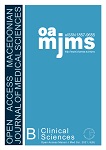Management of Infected Charcot Neuroarthropathy due to Diabetes Mellitus with Half Pins External Fixator and Pinning: A Case Series
DOI:
https://doi.org/10.3889/oamjms.2021.5220Keywords:
Charcot neuroarthropathy, Infected charcot foot, Osteomyelitis, External fixation, Diabetic foot, ComplicationAbstract
BACKGROUND: Charcot neuroarthropathy (CN) of the foot and ankle, which is complicated with infection, is debilitating disease and presents challenges until now. External fixation with half-pins is useful as provisional treatment.
AIM: The purpose of this retrospective case series is to summarize the patient characteristic, type of surgical intervention, outcome, and complication of infected CN treated in our hospital.
MATERIALS AND METHODS: This case series studied retrospectively patients with CN of the foot and ankle due to diabetes mellitus type II, complicated by infection, who required surgical treatment in a single institution, from 2018 to 2019. Diagnosis was based on chronic deformity (fracture or dislocation) as proven on X-ray and recently developed infection as shown through clinical, laboratory, and radiological evaluation.
RESULTS: We studied seven patients with CN classified as Eichenholtz Stage 3 (100%) and Brodsky type 3A alone (n = 3) (Figure 1), and type 3A with other types (n = 4). The mean age is 44.6 years old (range, 35–60) and mean body mass index was 24.08 kg/m2 (range, 21.45–25.39). Signs of infection include leukocytosis (n = 6), soft-tissue swelling (n = 4), ulcer (n = 4), and osteomyelitis (n = 1) at presentation. Operative treatment consisted of debridement, followed by external fixation only (n = 4), combined external fixation and pinning (n = 2), and intramedullary pinning only (n = 1). The mean hospital length of stay was 4.5 days (range, 3–7). We performed short-term follow-up after a mean of 4.12 months (range, 1.3–5.3) and long-term after a mean of 15.02 months (range, 11.27–16.8), the limb salvage rate was 100% in both. One patient had revision of external fixation. As for functional outcome, at the time of long-term follow-up mean visual analogue scale was 0.75 (range, 0–2) and American Orthopaedic Foot and Ankle Score was 66.25 (range, 57–77).
CONCLUSION: In this study, mostly external fixation with half-pins and methyl metacrylate was used based on the bone condition and patient’s compliance. Despite of its limitation, this method is effective when it is combined with strict blood glucose level and infection control.
Downloads
Metrics
Plum Analytics Artifact Widget Block
References
Goldsmith L, Barlow M, Evans PJ, Srinivas-Shankar U. Acute hot foot: Charcot neuroarthropathy or osteomyelitis? Untangling a diagnostic web. BMJ Case Rep. 2019;12(5):e228597. https://doi.org/10.1136/bcr-2018-228597 PMid:31088814
Ramanujam CL, Stapleton JJ, Zgonis T. Diabetic Charcot neuroarthropathy of the foot and ankle with osteomyelitis. Clin Podiatr Med Surg. 2014;31(4):487-92. https://doi.org/10.1016/j.cpm.2013.12.001 PMid:25281510
Short DJ, Zgonis T. Management of osteomyelitis and bone loss in the diabetic Charcot foot and ankle. Clin Podiatr Med Surg. 2017;34(3):381-7. https://doi.org/10.1016/j.cpm.2017.02.008 PMid:28576196
Pinzur MS, Gil J, Belmares J. Treatment of osteomyelitis in Charcot foot with single-stage resection of infection, correction of deformity, and maintenance with ring fixation. Foot Ankle Int. 2012;33(12):1069-74. https://doi.org/10.3113/fai.2012.1069 PMid:23199855
Saltzman CL. Salvage of diffuse ankle osteomyelitis by single-stage resection and circumferential frame compression arthrodesis. Iowa Orthop J. 2005;25:47-52. PMid:16089072
El-Gafary KA, Mostafa KM, Al-Adly WY. The management of Charcot joint disease affecting the ankle and foot by arthrodesis controlled by an Ilizarov frame. J Bone Joint Surg Br. 2009;91(10):1322-5. https://doi.org/10.1302/0301-620x.91b10.22431 PMid:19794167
Hernigou P. History of external fixation for treatment of fractures. Int Orthop. 2017;41(4):845-53. https://doi.org/10.1007/s00264-016-3324-y PMid:27853817
Haslbeck KM, schleicher E, Bierhaus A, Nawroth P, Haslbeck M, Neundörfer B, et al. The AGE/RAGE/NF-(kappa)B pathway may contribute to the pathogenesis of polyneuropathy in impaired glucose tolerance (IGT). Exp Clin Endocrinol Diabetes. 2005;113(5):288-91. https://doi.org/10.1055/s-2005-865600 PMid:15926115
Rogers LC, Frykberg RG, Armstrong DG. The diabetic Charcot foot syndrome: A report of the joint task force on the Charcot foot by the American diabetes association and the American podiatric medical association. Diabetes Care. 2011;34:2123-9. https://doi.org/10.1007/978-1-59745-075-1_14
Downloads
Published
How to Cite
License
Copyright (c) 2021 Maria Florencia Deslivia, Claudia Santosa, Putu Teguh Aryanugraha, Sherly Desnita Savio, Ketut Kris Adi Marta, I Wayan Subawa, Putu Astawa (Author)

This work is licensed under a Creative Commons Attribution-NonCommercial 4.0 International License.
http://creativecommons.org/licenses/by-nc/4.0








